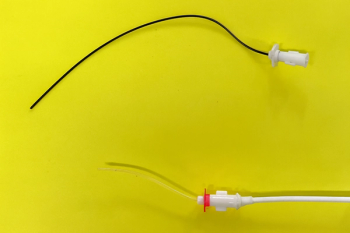
Is your crystalluria interpretation crystal clear?
Crystalluria can occur in animals with normal uinary tracts without any clinical signs of lower urinary tract disease.
Crystalluria can occur in animals with normal urinary tracts without any clinical signs of lower urinary tract disease. Why? Because the crystals are usually eliminated in the urine before they reach a large enough size to cause clinical problems. Even in animals that do have evidence of lower urinary tract disease, crystalluria itself does not contribute to the development of clinical signs. Although identification of crystals in otherwise healthy animals does not in itself necessitate therapy, it may indicate the need to perform further diagnostic tests to detect any underlying diseases or to monitor the patient for evidence of larger urinary stones (uroliths).
Figure 1: Cystine in the urine sediment of a dog (25X original magnification; unstained).
Causes of urine crystals and their relation to urolithiasis
Just because crystals alone do not cause clinical signs does not mean that they are a normal finding. Mineral crystals often form in the urine because there is a favorable environment. Many common crystals require that the urine be more acidic (e.g., calcium oxalate, cystine, xanthine), and others form in neutral or alkaline urine (e.g., struvite, calcium phosphate). Diet can influence urine pH, and some breeds can be predisposed to certain urine crystals. Additionally, crystalluria may be indicative of underlying subclinical disease in other body systems. For example, ammonium acid urate crystals are found in animals with liver shunts. Cystine crystalluria (Figures 1-4) results from a disorder characterized by an impaired ability to reabsorb the amino acid cystine. So identifying the type of crystals found in urine is important as it points to the likely cause of the crystalluria and perhaps to an underlying problem.
Figure 2: Six-sided cystine crystals (center) and calcium oxalate dihydrate (dipyramidal) crystals in the urine sediment of a dog (25X original magnification; unstained).
Urinary stone formation, or urolithiasis, is a concern in both dogs and cats and can result in serious illness. Crystals found in the urinary tract do not necessarily lead to the formation of uroliths, which are large stones that can cause urinary tract irritation and obstruction. However, crystalluria does represent a risk factor for urolith formation. In addition to crystalluria, other abnormalities must be present before uroliths develop. Struvite crystals are a common finding in both dog and cat urine but generally do not form uroliths unless there is also a bacterial infection.
Figure 3: Scanning electron micrograph of cystine crystals in the urine sediment of a dog.
Once crystals of one mineral type form in urine, the conditions can be improved for the formation of other types. In other words, a crystal of one mineral type serves as a risk factor for formation of crystals of other types and provides one explanation of why large, or macroscopic, uroliths may contain more than one mineral.
Figure 4: Aggregate of cystine crystals and red blood cells in the urine sediment of a 2-year-old domestic shorthaired cat with cystine urocystoliths (40X original magnification; unstained).
Combinations of minerals may be unevenly mixed throughout the urolith, or they may be deposited in layers (laminations). The core of some uroliths is composed of one mineral type (e.g., calcium oxalate), whereas outer layers are composed of different mineral types (e.g., struvite; Figures 5 & 6).
Figure 5: Radiograph of a compound urolith in an adult neutered male Yorkshire terrier. The center contains calcium oxalate (white arrow), and the shell contains struvite (green arrow).
In addition, some medications may also precipitate as crystals within the urinary tract and become incorporated within uroliths. Sulfadiazine is a notable example. Xanthine, resulting from excessive allopurinol dosing, is another (Figure 7).
Figure 6: Compound urolith removed from the dog described in Figure 5. The center contains calcium oxalate (white arrow), and the shell contains struvite (green arrow).
The key to interpreting a finding of crystalluria is to remember that the clinical significance needs to be evaluated along with all relevant clinical findings. Only then will the importance of the crystalluria be crystal clear.
Figure 7: Xanthine crystals in the urine sediment of a dog being treated with allopurinol. These crystals cannot be distinguished from ammonium urate crystals by light microscopy.
Tips for crystal-clear crystalluria interpretation
Here are some important considerations when looking for crystalluria:
1. Remember that crystalluria can only be confirmed by evaluating properly collected and processed urine sediment.
2. Examine fresh, nonrefrigerated urine samples.
3. Use refrigeration with caution when evaluating for crystalluria since refrigeration of urine samples may cause the formation of various types of crystals in vitro (Figure 8).
Figure 8: Variable sizes of calcium oxalate dihydrate crystals in the urine sediment of a dog. This sample was preserved by refrigeration (160X original magnification; unstained).
4. Keep in mind urine handling and collection factors likely to cause in vitro crystal formation or dissolution, which include bacterial contamination, temperature changes, length of storage and changes in urine pH. For example, if a urine sample with calcium oxalate crystals becomes contaminated with urease-producing microbes after collection, urine pH may become alkaline, resulting in struvite crystalluria as well, confusing diagnosis.
5. Evaluate the pH of the urine since many crystals tend to form and persist in certain pH ranges. A pH meter will provide more accurate measurements than most diagnostic pH reagent strips.
6. When more than one hour is expected to elapse between the time of collection and the time of analysis, measure urine pH at the time of collection and again at the time of urinalysis. Differences between the values suggest that in vitro changes have occurred and should be considered when interpreting the significance of crystalluria. This point is especially applicable when sending urine samples to diagnostic laboratories.
7. Be on the lookout for larger crystals (Figure 8), which indicate that the composition of urine is conducive to crystal growth.
8. Determine whether crystals are aggregating (Figures 4, 9 & 10) because crystals that aggregate represent a greater risk for urolith formation.
Figure 9: Aggregate of calcium oxalate dihydrate crystals in the urine sediment of a dog.
9. Verify the composition of urine crystals (Figure 11). Contact diagnostic laboratories for details about how to prepare and submit specimens.
Figure 10: Scanning electron micrograph of an aggregate of calcium oxalate dihydrate crystals in the urine sediment of a dog.
10. Consider whether other risk factors for urolithiasis (e.g., breed, sex, age, diet, concomitant illnesses) are present.
Figure 11: Sodium urate crystals in the urine sediment of a dog. These needlelike crystals are often mistaken for tyrosine crystals (128X original magnification; unstained).
11. Interpret the quantity of crystals in context of urine specific gravity values. A concentrated urine sample is usually more conducive to crystal formation.
12. Consider when the patient was last fed. Diet-associated crystalluria could be expected to increase in the postprandial state.
13. Don't forget that crystalluria may be influenced by diet, including water intake. Urine crystal formation that occurs while patients are consuming hospital diets may be dissimilar to urine crystal formation that occurs when patients are consuming diets fed at home.
14. Remember: Detection of crystalluria is not synonymous with the presence of uroliths. Crystalluria often is present in absence of uroliths. Conversely, uroliths can be present without concomitant microscopic crystalluria.
15. Repeat the urinalysis when significant crystalluria is detected in animals with otherwise normal urinary tract function. Persistent crystalluria usually represents a greater risk for urolith formation.
Dr. Osborne, a diplomate of the American College of Veterinary Internal Medicine, is professor of medicine in the Department of Small Animal Clinical Sciences, College of Veterinary Medicine, University of Minnesota.
For a complete list of articles by Dr. Osborne, visit
Newsletter
From exam room tips to practice management insights, get trusted veterinary news delivered straight to your inbox—subscribe to dvm360.





